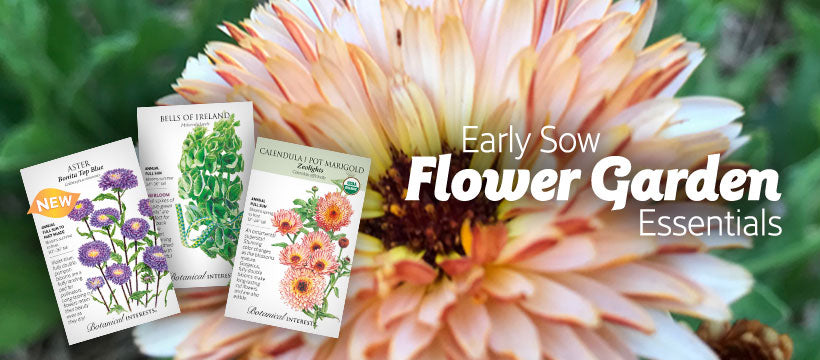Get ready, salads--home-grown cukes are on the way! Home-grown cucumbers have thin, tender skin that you won't need to peel. Cucumbers plants are fast-growing. It is best to train the vines up a trellis; the fruits will grow straighter and will be easier to find among the leaves, and a trellis frees up valuable garden space. This cool, summer, salad "must" is very easy to grow, and there is a cucumber variety to fit everyone's preference. If you were wondering how to grow cucumbers from seed, you've come to the right place!
General Information
Pickling cucumbers are usually stouter and have drier skins that are ideal for absorbing pickle brine. Slicing cucumbers have thinner, less bitter skins and longer fruit. Pickling cucumbers can be eaten like slicers, and slicers can be pickled when young.
Monoecious cucumbers have both pollen- and fruit-producing flowers on any given plant, while gynoecious has only fruit-producing flowers, therefore, a pollinator plant with pollen-producing flowers is required for fruit production. Because gynoecious plants put energy into only fruit-bearing flowers these varieties are generally very productive and fast to mature. In the absence of pollen, some varieties (parthenocarpic) produce seedless fruit. Often parthenocarpic varieties are gynoecious or have a high percent of fruit-producing flowers.
Cucumbers produce a chemical called cucurbitacin, which produces a slight bitter flavor mainly concentrated in the skin that causes minor indigestion in some people. Varieties with less of this chemical are referred to as "burpless".
General Sowing

When to sow outside: Direct-sow outside 1 to 2 weeks after your average last frost date, and when soil temperature is at least 60°F, ideally 70°–90°F.
When to sow inside: If starting indoors, sow 2 to 4 weeks before your average last frost date. Cucumbers are sensitive to root disturbance; sow in biodegradable pots that can be directly planted in the ground without disturbing roots
How to sow
Sow a group of 2 seeds every 12" at a depth of ½".
Thinning
When 3 leaves, thin to 1 plant every 12".
Optimal Growing Conditions
Soil
Soil should be light, well-drained and fertile; rich in organic matter.
Water
Cucumbers have a shallow root system and therefore require regular moisture, at least 1" per week. Moisture is particularly important during flowering and fruiting, since 96% of the weight of a cucumber is made up of water. Consider mulching plants to aid in moisture retention. If plants don't get enough water, fruit may be curved or constricted, and may be bitter.
Exposure
Choose an area with full sun (6 or more hours per day).
Fertilization
Apply a slow-release, balanced fertilizer (equal parts nitrogen, phosphorus, and potassium) to soil before sowing. Since root system is extensive, fertilize the entire growing area evenly, as cucumber root are susceptible to fertilizer burn when fertilizer is applied too densely around the base of the plant.

Special Care
When cultivating for weeds, be careful; roots are shallow. If planting in containers, a minimum of 10" soil depth and 14" diameter container is recommended. Cucumbers are heat sensitive. Several days of temperatures in mid 90s or more can prevent fruit set. Consider providing afternoon shade using other crops or a shade cloth if heat is a concern. Non-parthenocarpic varieties are dependent on pollination by bees. Sowing bee-attracting flowers in the area can attract bees and therefore increase yield. Otherwise, hand pollination of these varieties will be needed. To hand pollinate, transfer pollen from one pollen-producing flower to several fruit-producing flowers using a paintbrush or similar tool. Fruit-producing flowers have a miniature fruit at the base of the flower, while pollen-producing flowers do not.
Harvesting
Do not let cucumbers get too big; plants stop producing if there are overly mature cucumbers on the vine. Pick regularly before fruits are bigger than optimal size for the particular variety. Cut the stem rather than pulling at the fruit to break off. Once picked, immediately immerse in cold water to disperse "field heat", which increases the quality and life of picked fruit.
Storage
Store dry fruit in a plastic bag in the refrigerator for up to a week, but for best quality, pickle or eat fresh as soon after harvesting as possible.
Cucumber Comparison
| Variety | Sub-category | Type | Heirloom/ Hybrid | Plant/ Fruit Size | Disease/ Pest Resistance | Days to Maturity | Noteworthy | Other Common Names | Add to Cart | |
|---|---|---|---|---|---|---|---|---|---|---|
 | 'Armenian' | Slicing | Heirloom | 8' vine, 18"–36" long fruit | 65 | Monoecious, burpless, more closely related to a melon than a cucumber. Heat tolerant. | Yard long, serpent cucumber, snake melon. | |||
 | 'Homemade Pickles' | Pickling | 4'–5' compact vine, 1½"–6" long fruit | Anthracnose, angular leaf spot, cucumber mosaic virus, downy mildew, and powdery mildew | 55 | Monoecious, good for small gardens/ containers. | ||||
 | 'Hokus' | Gherkin | Pickling | 6' vine, 1½"–4" long fruit | 60 | Parthenocarpic | ||||
 | 'Lemon' | Slicing | Heirloom | 3'–6' vine, 3½" x 2½" round fruit | 65 | Burpless, somewhat drought tolerant, and non-bitter. | ||||
 | 'Marketmore' | Slicing | Heirloom | 4'–6' vine, 6"–8" long fruit | Cucumber mosaic virus | 60 | Monoecious | |||
 | 'Poinsett 76' | Slicing | 4–6' vine, 7"–8" long fruit | Anthracnose, angular leaf spot, downy mildew, powdery mildew, and scab. | 65 | Monoecious, heat and humidity tolerant. | ||||
 | 'Spacemaster 80' | Slicing, Pickling | 2'–3' vine, 7"–8" long fruit | Cucumber mosaic virus, downy mildew, powdery mildew, and scab. | 62 | Monoecious, good for small space and containers. | ||||
 | 'Tasty Green' | Slicing | Hybrid | 6'–7' vine, 9" long fruit | Powdery mildew and tolerance of downy mildew | 60 | Japanese type, monoecious, thin skin, non-bitter, burpless, small seeds. | |||
 | 'Telegraph Improved' | Slicing | Heirloom | 8' vine, 10"–18" long fruit | 60 | English type, parthenocarpic, thin skin, burpless. | ||||


